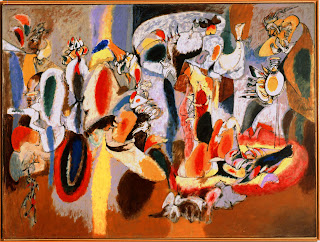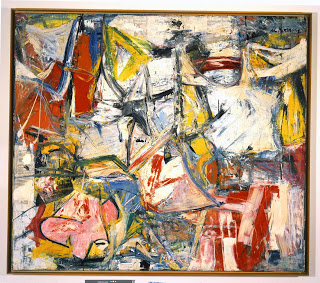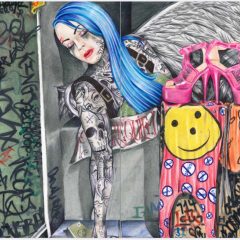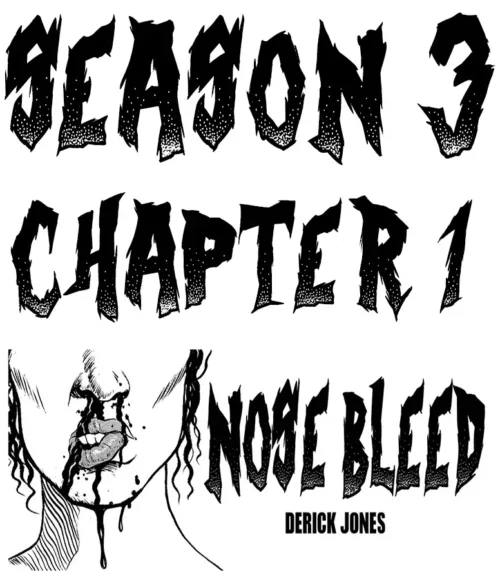
Jackson Pollock, Totem Lesson 2, 1945, oil on canvas. National Gallery of Australia, Canberra, Purchased 1986. © The Pollock-Krasner Foundation/Artists Rights Society (ARS), New York.
Action/Abstraction: Pollock, De Kooning and American Art, 1940-1976 at the Jewish Museum through September 21, 2008 is interesting for its contents and its ambitions; it will appeal to viewers with knowledge of Abstract Expressionism and its impact on artists of the next generation as well as anyone with a serious interest in how art worlds function, at least in one striking example. This is not an introduction to Abstract Expressionism nor even to art in New York during the period covered; rather it’s a survey of the artistic culture around the art that includes some prime examples of painting and sculpture (50 in all). If you don’t know Arshile Gorky’s The Liver is the Cock’s Comb in the flesh, it alone will make the exhibition worthwhile (although Philadelphia visitors will be able to see it in the Gorky retrospective that Michael Taylor is organizing for the PMA).
Such an contextual approach is standard in ethnographic museums but rare in museums devoted to European and American Art. It’s even more striking in dealing with a period so recent that many viewers will have known some of the participants and a few more senior visitors may even be able to say I remember that! It follows the impact of two critics who were significant in situating the art of their time: Clement Greenberg and Harold Rosenberg. There was no love lost between them, for they took incompatible stances towards the group of artists who would come to be lumped together under the label (which many disliked) of Abstract Expressionists.

Arshile Gorky, The Liver Is the Cock’s Comb, 1944, oil on canvas. Albright-Knox Art Gallery, Buffalo, N.Y., Gift of Seymour H. Knox, Jr., 1956. © Artists Rights Society (ARS), New York.
This was the first and is probably the last time that critics had a defining impact on contemporary American art. It may also be the last time that cutting-edge art receives extended attention in non-specialist publications such as Life magazine, the Nation and Vogue. Both men began writing on a variety of subjects for small, left-wing magazines and only became widely-known for their art criticism after World War II. Rosenberg, whose initial salvo was an article titled The American Action Painters, saw paintings as records of the artists’ existential struggles; he spoke of them as an arena in which to act, and described a brushstroke as a gesture of liberation, from Value – political, esthetic, moral. Greenberg, on the other hand, focused on paintings as a criticism of prior painting which in this period meant concern with the flatness of the canvas in abstract works freed from both external imagery and any illusion of space. He was always highly prescriptive and his critical approach is termed formalist (although here I must admit to a personal experience: in the mid 1980s I was asked to introduce Greenberg, who was giving a lecture at the museum where I was curator. I described his approach as formalist and the first comment he made upon taking the podium was to dismiss the term).
The exhibition begins with a series of comparisons demonstrating the differing critical approaches: Pollock and de Kooning, Arshile Gorky and Hans Hofmann. It then turns to work by women and artists of color who were left out of the critical debate: Lee Krasner, Grace Hartigan and Norman Lewis. The following section consists of sculpture by David Hare, Herbert Ferber, Ibram Lassaw, Seymour Lipton and David Smith; while their work paralleled that of the painters in many respects it was not central to the critical arguments. The last area of the ground floor includes work by Clifford Still, Mark Rothko and Ad Reinhardt whose work raised certain issues untouched by either critic, then work by Barnett Newman whose work appealed to both.

Separate context rooms display magazines, books, exhibition catalogs, photographs and some wonderful correspondence by both artists and critics. I was delighted with the exchange between the notoriously-prickly Clifford Still and Clement Greenberg in which Still writes Your article … makes it necessary for me to write you a rather unusual letter. I am doing it only because you have got your chin, and mine, away out. You may be tough enough to take what is being planned for you, but I am not at all pleased by what has started to come my way.
The part of the exhibition upstairs is less cohesive and raises many questions about who was included and why. First are the next generation of artists that interested Greenberg: the Color Field painters Helen Frankenthaler, Morris Louis, Kenneth Noland, Jules Olitski and abstract sculptors Anthony Caro and Anne Truit; then an odd group of artists that demonstrated the continuing significance of gestural painting or Rosenberg’s concept of the anxious object: Peter Saul, Lee Bontecou, Claes Oldenburg, Jasper Johns, Joan Mitchell and a late figurative Philip Guston. It ended with two artists whose work continued ideas of action and abstraction in ways beyond the critical parameters set by Greenberg and Rosenberg: Frank Stella and Allan Kaprow.
The most obvious omission, in terms of the (negative) influence of Clement Greenberg are Donald Judd and Robert Morris. As the first generation of artists who’d done graduate work, they had the rhetorical skills to meet the critics head-on in their writing; and they did. In 1965-66 both artists conducted a back and forth debate with Greenberg and his (then) disciple, Michael Fried about criteria in contemporary art and who should choose them. It was conducted on the pages of Artforum, Art Yearbook and Art International, and it was in this context that Greenberg brought up the work of Ann Truitt.
I also wonder at the exclusion, among others, of Robert Rauschenberg (with his rejection of the Romantic gesture and his later interest in collaborative, interdisciplinary work with Nine Evenings), Andy Warhol (who rejected originality as well as gesture), Christo (creating impermanent work that incorporated the political process and administration of large groups of assistants), Dan Graham, Mel Bochner and other conceptual artists (for rejecting almost all the terms of the earlier criticism), or the East Village cooperative which opened the Lannis Museum of Normal Art, in 1967, dedicated to Ad Reinhardt .
But hey, that’s another show. One exhibition can’t do everything, and Action/Abstraction which contextualizes the art around That oldtime Jewish sect called American art criticism (Max Kozloff’s phrase used as the title of the catalogue essay by Mark Godfrey) is a good place to start.









